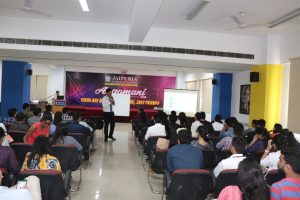 The making of a successful entrepreneur or manager starts with choosing the right business school, selecting the correct specialization, and then getting the most out of the 2-year MBA program.
The making of a successful entrepreneur or manager starts with choosing the right business school, selecting the correct specialization, and then getting the most out of the 2-year MBA program.
Graduates fresh out of college may be spoilt for choice while picking among the best business schools of India, but a few yardsticks can help them reach a smart decision. What are the B-school’s credentials? What is its legacy? How good are the infrastructure and facilities? How qualified and experienced is the faculty? And how well is it connected with the industry?
Jaipuria School of Business, Ghaziabad, ticks all these boxes. A premier institute of teaching and learning, it is one of the best PGDM colleges of India. It is backed by Seth Anandram Jaipuria Group’s legacy of 75 years in education. It provides state-of-the-art infrastructure for business education, has a highly qualified faculty, and an industry-integrated program that also gives students exposure to the global corporate environment.
The second step – choosing the best PGDM/MBA specialization – is a matter of aligning one’s interest with the options available. The PGDM specializations for students offered by Jaipuria School of Business cover the whole gamut. Students have the option of specializations in finance, marketing, human resource, business analytics, operations and supply chain management, and international business.
Once a student selects the best PGDM stream, the 2-year program begins in earnest. This duration of 2 years is a very important period for students who aspire for professional expertise and excellence in the chosen aspect of business education.
Being one of the top management institutes in India, Jaipuria School of Business provides periodic guidance and motivation to students who want to get the best out of a 2-year PGDM program.
Here are some pointers to keep in mind.
- Keep yourself updated about the industry
Back your classroom learning with up-to-date knowledge of the corporate world, particularly the industry you are interested in. Know the latest business models that are emerging and how they perform. Get practical knowledge of the disruption caused by technology and new business models.
- Interact with peers and professors
Discussions with peers and professors go a long way in enhancing one’s learning at a B-School. In case of doubts, do not hesitate to approach the professors who are always eager to explain and simplify concepts for inquisitive students. Peer-to-peer debates bring diversity in discussions and broaden a student’s understanding of the business world.
- Study hard, but don’t ignore extra-curricular activities
There is no denying that the best management education in India demands students to study hard, but then nothing worthwhile in life ever comes easy. The atmosphere at Jaipuria School of Business is conducive for students who aspire to academic excellence. Yet, we encourage students to take the time for sports and extra-curricular activities as well. The college campus has a well-stocked library, but also a huge sports ground for football, cricket, volleyball, badminton, and other sports.
- Apply for multiple internships
The internship is a student’s first exposure to the corporate world. Teachers at Jaipuria School of Business counsel students in choosing the most beneficial B-school internships, but it is eventually up to students to make the most of these opportunities. For broader exposure to the business world, we recommend multiple internships.
- Make a plan to kickstart your career
A good plan today is better than the best plan tomorrow. So, gear up and start charting out a plan to kickstart your career. Educate yourself about the nitty-gritty of the structured employability assessment and placement support through AON CoCubes provided by Jaipuria School of Business. Students who are well-versed with these methodologies stand a greater chance of landing a plum job right out of a business school.
 Frontiers of knowledge are vast, infinite and endless. They are somewhat like the horizon which appears close, but as you move towards it, it leaps several miles ahead of you. You keep repeating this process and the real horizon (It does not exist and is only an optical illusion) will continue to elude you. You stand on a beach with the ocean of knowledge lying in front of you. Drink as much water of knowledge that you can assimilate, and yet you will remain thirsty, literally and metaphorically.
Frontiers of knowledge are vast, infinite and endless. They are somewhat like the horizon which appears close, but as you move towards it, it leaps several miles ahead of you. You keep repeating this process and the real horizon (It does not exist and is only an optical illusion) will continue to elude you. You stand on a beach with the ocean of knowledge lying in front of you. Drink as much water of knowledge that you can assimilate, and yet you will remain thirsty, literally and metaphorically. One of the most interesting age-segments in the life span of all of us, undeniably, is 10-15 years, when most of the school-going children are studying in classes ranging from 5th to 9th. Much has been written about the toddlers and young children in the age group 1-8 years. Parents and child psychologists seem to spend more time in tending and researching this age-group for several reasons, and one of them happens to be a general perception of fragility in the physical and cognitive context.
One of the most interesting age-segments in the life span of all of us, undeniably, is 10-15 years, when most of the school-going children are studying in classes ranging from 5th to 9th. Much has been written about the toddlers and young children in the age group 1-8 years. Parents and child psychologists seem to spend more time in tending and researching this age-group for several reasons, and one of them happens to be a general perception of fragility in the physical and cognitive context. Any phenomenon or a disease that assumes pandemic proportions generates huge levels of fear affecting every resident of our planet. Ironically, its microscopic dimensions, invisibility and parasitical character makes it extremely dangerous. It draws its destructive power from the host it infects, multiplies, and in a short period of time damages several of the host’s vital organs by reducing the supply of oxygen. If the affected person is weak, old or suffers from other physical morbidities, its impact becomes more severe.
Any phenomenon or a disease that assumes pandemic proportions generates huge levels of fear affecting every resident of our planet. Ironically, its microscopic dimensions, invisibility and parasitical character makes it extremely dangerous. It draws its destructive power from the host it infects, multiplies, and in a short period of time damages several of the host’s vital organs by reducing the supply of oxygen. If the affected person is weak, old or suffers from other physical morbidities, its impact becomes more severe.
 Digital Marketing Club of Jaipuria School of Business “Digital Spartans” has organized a 21 days long blogging contest for Students of PGDM, Jaipuria School of Business.
Digital Marketing Club of Jaipuria School of Business “Digital Spartans” has organized a 21 days long blogging contest for Students of PGDM, Jaipuria School of Business.









